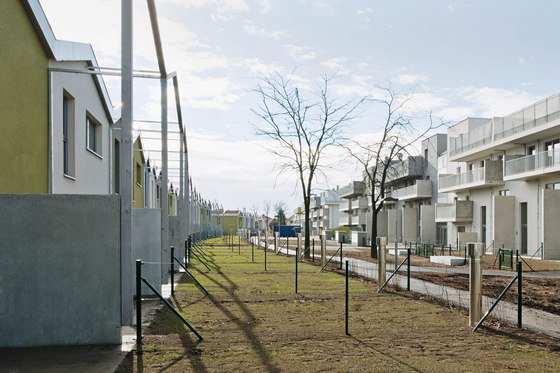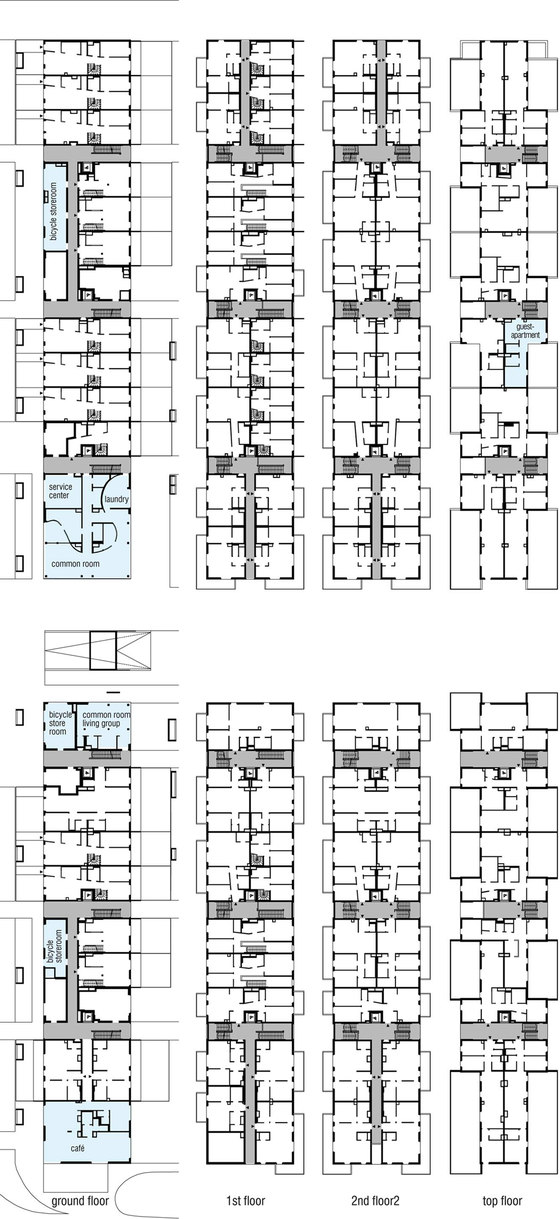Our cities are growing, and their limits are increasingly expanding. The project “Die Grüne Welle” (“The Green Wave”) of architect bureau SUPERBLOCK and housing developer WBV GÖD, featuring an exemplary residential complex on the periphery of Vienna – between the city and the countryside – is now completed. In 2010 the project won a housing developer competition for ”safe living”. The urban “village-green” arrangement and functional density of this subsidised housing development (including terraced houses and multi-storey buildings) strengthens neighbourly ties, whereas its typological diversity promotes cross-generational and social mixing between residents.
Inspired by Victor Hufnagel’s 1983 housing complex, which at that time already pursued the idea of a densified garden-city, „Grüne Welle“ boasts a linear “village green” arrangement. This helps avoid scattered urbanisation and leaves aside non-useable buffer zones.
The “village green”, framed by two rippled lines of terraced houses, explicitly divides the outdoor areas into shared (village green) and private (garden) space. The terraces are accompanied by a unit of multi-storey apartment blocks, which feature common rooms and a garage that are also available to terrace residents.
The multi-storey apartment blocks, running along the newly-built terraced development, provide a spatial connection between the complex and the planned densely built-up residential area. The wave-inspired aesthetics of this terraced complex enclose the central “village green” area, which serves as an open access communication zone and shared space. This area is meant to bring different groups of residents together and to serve as a location for various shared facilities: playgrounds, bicycle parking, dog parks, as well as front yards, which can be designed and arranged by their owners.
The „village green“ area, as a busy common space for the local community, stands in contrast to the quiet back yards behind the terraces. These back yards will be made even more private thanks to the plantable pergola construction. All apartments in the multi-storey blocks are also provided with big gardens, balconies or roof terraces, which lend the facade a profound sense of plasticity through their exposed-concrete side walls.
In order to form manageable communities, residential units are segmented into smaller groups – housing units of at most eight terraced houses and “stairwell communities” of no more than sixteen apartments. These constellations promote a sense of security, which is further strengthened by various socially sustainable arrangements, such as an explicitly dog-friendly environment and the two caretakers who, being residents of the community themselves, provide low-threshold facility management.
Functional density and a sustainable mix of future resident groups are essential to a strong social fabric:
The terraced house settlement consists of three types of houses of differing dimensions. The largest of these, at 140m², offers enough space for a multi-member family or combined work and home space, while the mid-sized model, at 95m2, meets the classic demand for four rooms. The smallest model, with its 65m2 and three rooms, offers everything a household needs and, with correspondingly low costs, makes home ownership in a green area possible for diverse social groups and non-traditional families.
The multi-storey residential buildings also offer a wide variety of apartment options: maisonettes extending from front to back on the ground floor, above them compact two- or three-room apartments and, at the top, different penthouses. An entire stairwell, including common room, is available to each living unit and with accompanying social moderation, represents a model of a close neighbourhood community. Overall, 10% of the units (terraced houses and apartments) were built to be accessible to residents with impairments. These residents were deliberately targeted right from the tendering process onwards. For instance, informative material for disabled persons’ associations was made available, and info-events were initiated (e.g. in integrative schools, Verein Balance).
During the settling-in phase the residents’ group and the various initiatives were overseen by “Wohnbund_Consult” (an independent agency for sustainable urban development, housing and construction) and the outdoor areas – by “Land in Sicht” (a landscape planning agency).
The ground floor fulfils various functions related to daily needs: bicycle and stroller storage, laundry room, an ATM, a multifunctional common room, and the Service Centre, the first point of contact for residents with problems or questions.
Happily, two of the terraced houses are home to supervised youth groups from “SOS-Kinderdorf” (orphan charity organisation), and special-needs residents are taking advantage as well, as there has been strong demand for accessible apartments.
All-in-all, a residential development has been created that is adaptable to private, professional or health-related changes in the lives of residents, and as such can serve as a sustainable, long-term home.
SUPERBLOCK ZT GmbH
interior multistorey-building, maisonette type 2, ground floor
multistorey-buildings maisonettes, walls of exposed concrete generate a sculptural facade
multi-storey buildings, view Grellgasse

























